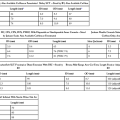Symptoms are very uncommon. However, a child with an obvious deformity may experience unfortunate psychological effects. Funnel chest is usually associated with postural disorders such as forward displacement of the neck and shoulders, upper thoracic kyphosis, and a protuberant abdomen. Functional heart murmurs and benign cardiac arrhythmias are frequently seen in these individuals, and the electrocardiogram may show right-axis deviation because of the displacement of the heart. In older patients, there may be an appreciable incidence of chronic bronchitis and bronchiectasis.
Depression of the sternum begins typically at the junction of the manubrium and the gladiolus. The xiphoid process may be bifid, twisted, or displaced to one side. Costal cartilages are angulated internally, beginning with the second or third and extending caudally to involve the remainder. In general, the defect tends to be symmetric, but one side may be more depressed than the other so that the sternum deviates from the middle line. An estimate of the cavitary volume may be obtained by filling the depression with water while the patient lies supine. Standard radiographic films reveal that the heart is displaced toward the left side, and lateral films show the displacement of the body of the sternum posteriorly.
In patients who are symptomatic or who show a significant progression of pectus excavatum, the deformity should be corrected surgically. Because most of the operations are carried out with a cosmetic end in mind, the results are best when surgery is performed between 3 and 7 years of age. Surgical correction consists of excision of the hypertrophied costal cartilages on both sides; osteotomy of the sternum at the junction of the manubrium and body; and then internal fixation by pins or rods, which are removed later. Fixation by a metal strut or wire is required in older patients to prevent recurrence of the deformity, which, in some degree, may occur despite initial overcorrection.
PECTUS CARINATUM
Also known as pigeon breast, chicken breast, or keel breast, this is a protrusion deformity of the anterior chest wall that is unrelated to pectus excavatum and occurs about one-tenth as often. Two principal types are recognized: (1) chondromanubrial, in which the protuberance is maximal at the xiphoid and the gladiolus is directed posteriorly so that a secondary saucerization is evident, and (2) chondrogladiolar, in which the greatest prominence is at or near the gladiolus. The pathogenesis is no better understood than that of pectus excavatum, but the theory of unbalanced or excessive growth of the cartilages makes sense. Although functional cardiac and respiratory difficulties have been observed, the chief reason for surgical correction is cosmetic. If the deformity is minor, no treatment is required. When operation is necessary, the procedure should be tailored to the particular deformity, taking into account the full life circumstances of the patient. When the deformity causes embarrassment, the surgical procedure is aimed at achieving psychological as well as physiologic improvement.
BIFID STERNUM
Failure of fusion of the sternal bands may occur, creating a defect of the anterior chest wall. Separation of the sternum may be complete or incomplete and may be associated with an ectopia cordis. When the defect is incomplete, surgical correction of the abnormality may be accomplished. If the repair cannot be effected by primary approximation of the sternal segments, a prosthesis or a cartilage autograft may be used.
Other deformities of the chest wall occasionally seen include cervical ribs (with or without compression of the brachial plexus and artery), partial absence of ribs, supernumerary ribs, and thoracic-pelvic-phalangeal dystrophy.
SKELETAL DISORDERS PRESENTING WITH NEONATAL RESPIRATORY DISTRESS
Respiratory distress may result from abnormal lung growth caused by restriction by limited rib growth such as from osteochondrodysplasias (e.g., asphyxiating dystrophy, thanatrophic dwarfism, upper airway obstruction [diastrophic dysplasia]) or abnormal bone, cartilage, or collagen development, leading to a small or abnormal thoracic cage (hypophosphatasia, achondrogenesis, osteogenesis imperfecta).




